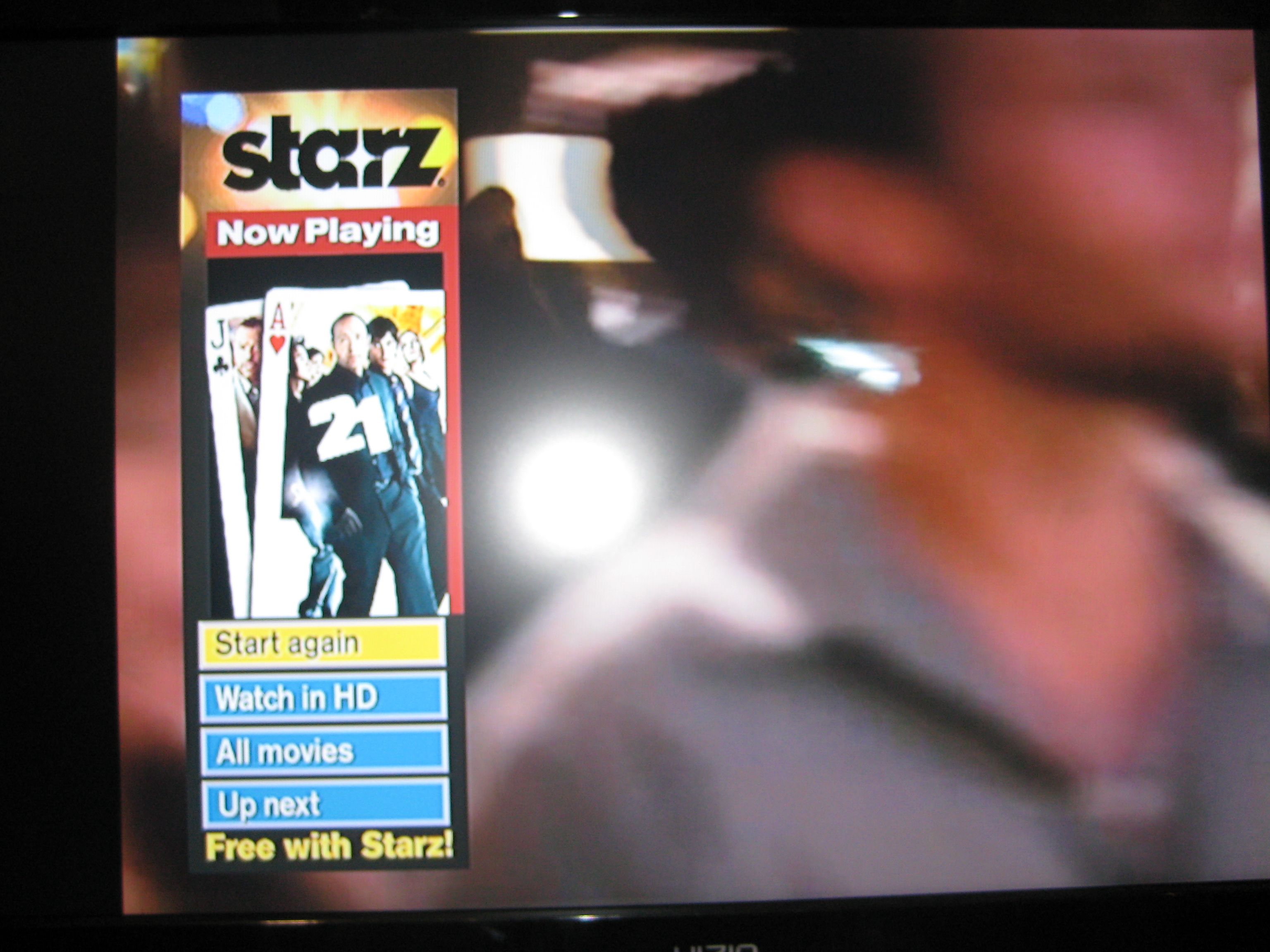Interactive Television Is Here Again. Want Anchovies With That?

WASHINGTON, D.C. -- You’ve been waiting for more than three decades to “interact” with your television, voting for your favorite local candidate, shopping for shoes, or, of course, ordering a pizza.
That was the implicit promise of cable television systems, since the launch on Warner Communications’ Qube system in December 1977 in Columbus, Ohio. The ideas helped win the right to dig up city streets to lay cables all over the country. The promise came again in 1994, when Time Warner Cable launched its Full Service Network in Orlando, Fla.
And here we were, standing in the CableNet exhibit space on Thursday, seeing once again an official christening of the dawn of interactive television.
The application was simple. The chairman and CEO of Starz LLC, Bob Clasen, hit two buttons on a remote control and brought up a mini-guide to Starz movies on screen (above). Want to restart the movie you’re looking at? Fine. One click. Want to see what else Starz offers? Fine. Another click.
You figured that was something cable TV already did. Right? Nope. This was one of the first interactive applications being delivered under a standard developed by the industry’s research arm, CableLabs, called the Enhanced Binary Interchange Format. This allows simple, small applications of say, 300,000 characters to be sent and stored in just about any set-top box, old or new.
Which makes it a big deal, in the estimation of CableLabs’ president, Dick Green, who has headed the industry’s research efforts for more than two decades.
"Remember: this can be deployed on any of the legacy boxes,’’ meaning old, basically dumb pieces of hardware. “So the deployment for interactive television now is here. It is real. This is solid. Interactive television has been around for a long time as you all well know. But this is really here and it really works,’’ he said.
It really works – and it’s really about selling stuff.
If you wander around the CableNet exhibit area or the 2009 Cable Show floor, it’s clear that the promise of interactive television now is to move merchandise.
Take what’s being built on the EBIF platform of Biap, Inc., of Plano, Texas.
Sure, there’s a “personalized information” service that lets a user designate just what news he or she wants to see at the flick of a finger. The system allows a person to specify news about, say, the Dallas Cowboys or travel destinations, like Turks and Caicos.
The benefit? Ad modules and prompts can be built that let advertisers later try to market, say, season tickets to Cowboys games or a vacation package to guess where.
Other apps built on the Biap server and “agent” in your set-top box are more straightforward.
--Find out more. The “request for information’’ function will be built into the ads you see on your cable TV screen. Watching a Ford ad? You’ll be able to choose to see more information and get brochures sent to you on the truck of your choice, using icons for the F150, the Ranger, etc.
--Talk to someone. When that ad about your yard being pulled away by flood waters shows up, expect a dialogue window that asks if you want your local EveryState agent, Bob Jenkins, to call you.
--Sign up. Like “The Tudors” on Showtime? Next time it comes on, you may get to see interviews with the cast, behind the scenes stories, out takes and such – just as on a DVD. You might even get prompted with a “reminder” window to be told – when you’re watching another show – that a new episode is coming on. Or to record future episodes, with one more click. And, hey, if you looked at all this stuff and are not a subscriber, signing up will be just one or two more clicks. (Of course, if you want to disconnect, it won’t be that simple. You’ll probably have to call in for that).
Now, how about that pizza ordering?
Apps for that (or other forms of shopping) will come in two forms. Any and all cable systems will be able to provide the basic ordering of a pizza through an EBIF app. This works, but is kind of slow. You click on a "call me" button. The system does in fact call you and get you on the phone, which takes about 15 seconds. Then, it calls the pizza outlet, which takes another 10 seconds. You'd be better off just taking the magnet off your refrigerator door and calling direct.
But if you really want to show the brocolli in mouth-watering high def form, you’ll have to see it in a form that makes use of a more advanced and more open display and transaction technique called tru2way, notes Vibha Rustagi, co-founder, president and CEO of the Atlanta-based interactive television services and support firm, Itaas. company, itaas.
This will make interactive video games such as Tetris more engaging. Or allow you to set up teleconferences with friends and family, using your cable phone service and name-driven directories. Or go straight to the video, when you buy that set of golf lessons through your Paypal account.
Interestingly, that purchase will show up on your personal Facebook feed, if you are set up properly in that social network. So, friends that follow your activities will know that you have bought that golf instruction video. And if they click on your update, they can go to the selling site and purchase the video for themselves.
Now, can you see your friends updates (or, your own?) on your cable-connected TV set?
Nope.
But show a cable operator how that will translate into more merchandise or programming sales and you’ll see it on your TV, computer and smartphone screen in a matter of months.
Your EBIF or tru2way platform expert will see to that.
Hey, it can’t be that hard to show 140-character tweets at the bottom of your TV screen, just like the caller ID messages you’re already getting.
If this is the interactive TV you want, tell your cable operator. Now.
